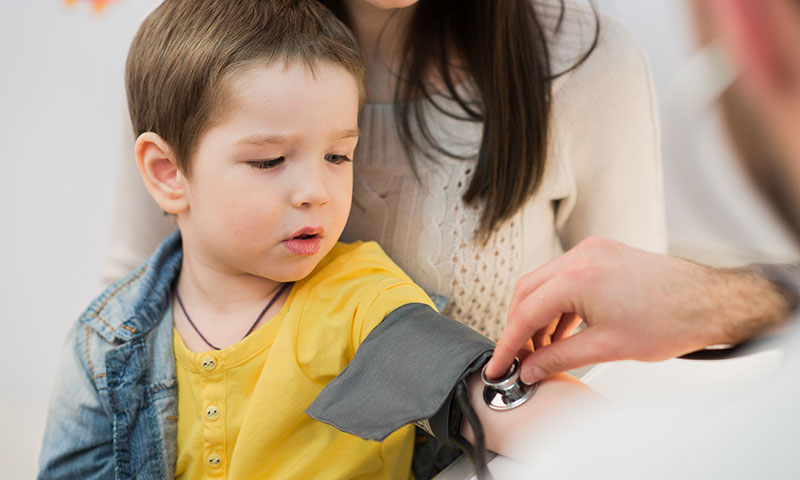
A common misconception about hypertension, otherwise known as high blood pressure, is that it only happens to adults and old people. Unfortunately, children are also susceptible to having high blood pressure because this condition can affect people of any age.
As with adults and seniors, hypertension in children is an alarming problem. The good news is that you can help prevent and control your child’s high blood pressure. The first step is to learn why it happens.
Healthy blood pressure in children
Blood pressure refers to the force in the arterial walls as your heart pumps blood throughout your body. There are two numbers that are used when measuring it: the systolic pressure and diastolic pressure.
Systolic pressure refers to the amount of pressure in the arteries as your heart contracts. It is the top number in the reading. Diastolic pressure refers to the amount of pressure in the arteries as your heart relaxes. It is the bottom number in the reading.
For example, if the reading is 120/90, the systolic pressure is 120 and the diastolic pressure is 90.
Determining the normal range of blood pressure in children is relative. There are several factors that will need to be considered, such as gender, age, weight, and height. Your child’s pediatrician will be able to determine this number.
How can children develop high blood pressure?
Hypertension happens when the force of the blood that is pushing through the arterial walls is too high. As a result, the heart has to pump harder and the arteries are under greater tension than they normally are.
The specific cause of high blood pressure is unclear. However, there are factors that increase a child’s risk, such as:
- Genes
- Obesity
- Certain medications
- Family history
- Too much sodium in the diet
- Lack of physical activity
If left untreated or uncontrolled, high blood pressure can lead to fatal diseases in children. It can cause heart and kidney diseases, eye problems, and even stroke.
Hypertension is more common in adults, but children and teenagers can be affected too. This is especially true for kids that are obese. It is one of the most common risks of high blood pressure. Obesity may be caused by several factors:
- Too much consumption of unhealthy food. Some children have bigger body frames due to genetics, but obese kids have above the normal weight for their age and height. This happens when children eat too much food than their body needs, causing enormous weight gain.
Often, it is caused when a kid’s diet is full of unhealthy food. Chips, chocolates, candies, fast food, soda, and juices are the common culprits. These foods are loaded with salt, sugar, and empty calories that are bad for the child’s health.
- Lack of physical activity. In addition to a poor diet, lack of exercise can lead to high blood pressure in children. Nowadays, kids can find entertainment through gadgets and electronics. This sedentary lifestyle reduces their time to play outside and exercise.
It’s important to watch your child’s diet and let them engage in physical activity to reduce their risk of hypertension.
Symptoms of high blood pressure in children
Oftentimes, hypertension doesn’t display any symptoms. During doctor visits, kids often have high blood pressure because they are anxious or nervous. This makes it more difficult to diagnose hypertension in just a few visits.
To help you get accurate blood pressure readings, it’s important to monitor your child’s blood pressure at home regularly. There are blood pressure monitors for kids that you can get from https://www.raycome.com/ that are easy to operate. Then, you can relay their measurement to the pediatrician.
In severe cases, high blood pressure causes dizziness, nose bleeding, racing or fluttering heart, headaches, nausea, and blurry vision.
How is high blood pressure in children treated?
In most cases, there is no need for children to take medications to treat hypertension. The pediatrician will most likely recommend lifestyle changes. Examples of this include:
- Serve a healthy diet. Prepare home-cooked meals for your child that are fresh and nutritious. For a detailed guide, you can follow the Dietary Approaches to Stop Hypertension (DASH) diet plan. But basically, it includes eating vegetables and fruits and reducing fatty, salty, and sugary foods.
Consulting a dietitian can help you plan healthier meals that will suit your child’s palate. Take note that having a healthy diet doesn’t mean restricting your child from their favorite foods. You can let them indulge sometimes, but not regularly.
- Engage in physical activity. Exercise is important in keeping your children physically fit. At least 15 to 30 minutes of daily physical activity is needed for children. They don’t have to go to the gym or use fancy exercise equipment to do this. Doing simple tasks such as letting them help you mop the floor, tend the garden, or walk the dog.
Still, the best way to let kids engage in physical activity is by letting them play. Not only does it benefit them physically, but it also enhances their social and mental skills.
- Monitor their blood pressure regularly. This will help you determine if the lifestyle changes you’re doing are working for your kid. It will also help your doctor make an accurate diagnosis and treatment plan.
Conclusion
High blood pressure among children is possible, but it is preventable and manageable. There are many factors that can increase their risks, such as their genes and family history. However, with the proper lifestyle adjustments, you can ensure that your child’s blood pressure remains normal.